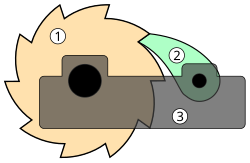This article needs additional citations for verification .(November 2023) |

Red arrows indicate which way force is applied to the gear.


Red arrows indicate which way force is applied to the gear rack. The rack and pawl are both restricted to only linear movement (not shown).
A ratchet (occasionally spelled rachet) is a mechanical device that allows continuous linear or rotary motion in only one direction while preventing motion in the opposite direction. Ratchets are widely used in machinery and tools. The word ratchet is also used informally to refer to a ratcheting socket wrench.


